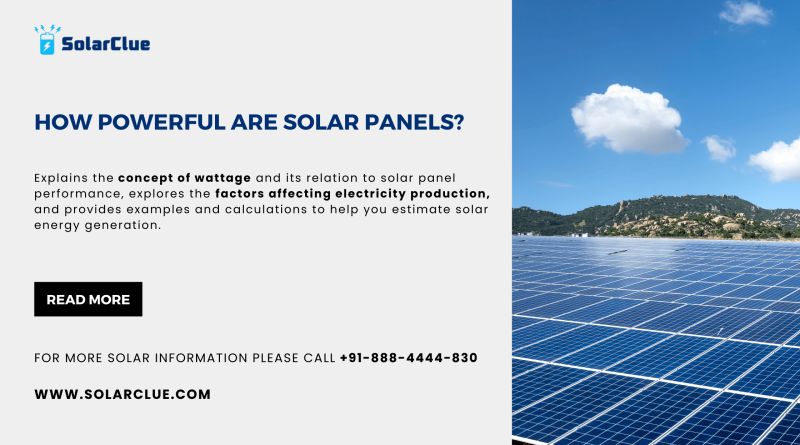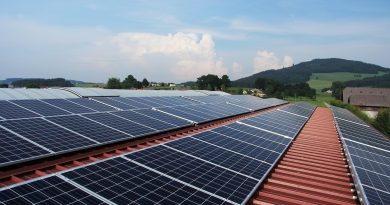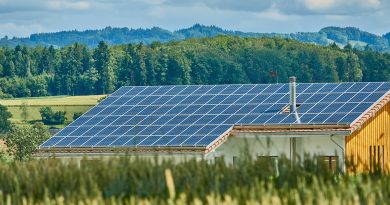How Powerful Are Solar Panels?
Understanding solar panel power output is crucial for anyone considering installing solar energy systems, whether for residential, commercial, or industrial purposes. This blog explains the concept of wattage and its relation to solar panel performance, explores the factors affecting electricity production, and provides examples and calculations to help you estimate solar energy generation for your specific location.
Table of Contents
- 1 The Role of Wattage in Solar Panel Performance
- 1.1 Factors Influencing Solar Panel Power Output
- 1.2 Factors Affecting Solar Panel Power Output
- 1.3 Calculating Solar Panel Energy Production
- 1.4 Comparing the Power Output of Different Solar Panel Types
- 1.5 Maximizing Solar Panel Power Output Through Optimization
- 1.6 The Impact of Weather Conditions on Solar Panel Power
- 1.7 The Role of Inverter Efficiency in Power Output
- 1.8 Measuring and Monitoring Solar Panel Performance
- 1.9 The Future of Solar Panel Power Output and Efficiency
- 1.10 Common Misconceptions About Solar Panel Power
- 1.11 Conclusion
- 1.12 FAQ Section
The Role of Wattage in Solar Panel Performance
Wattage Explained:
- Definition: Wattage is the measure of electrical power, represented in watts (W), that a solar panel can generate under standard testing conditions (STC). It indicates the maximum power output a solar panel can produce when exposed to sunlight.
- Panel Ratings: Solar panels are typically rated between 250W to 450W, depending on their efficiency and size. Higher wattage panels produce more electricity, making them ideal for installations with limited space.
Factors Influencing Solar Panel Power Output
Panel Efficiency:
- Efficiency Rating: Efficiency refers to the percentage of sunlight that a solar panel can convert into usable electricity. Higher efficiency panels produce more power per square meter.
Sunlight Intensity:
- Solar Irradiance: The amount of sunlight that reaches the solar panels, measured in kilowatt-hours per square meter per day (kWh/m²/day). Higher solar irradiance results in higher power output.
Temperature:
- Temperature Coefficient: Solar panels typically lose efficiency as the temperature rises. The temperature coefficient indicates how much power output decreases with each degree Celsius increase above 25°C.
Panel Orientation and Tilt:
- Optimal Positioning: Solar panels should be oriented towards the sun, with the optimal tilt angle depending on the latitude of the installation site. Proper orientation and tilt maximize exposure to sunlight, thus increasing power output.
Factors Affecting Solar Panel Power Output
| Factor | Impact on Power Output | Explanation |
|---|---|---|
| Panel Efficiency | Higher efficiency = more power output | Efficient panels convert more sunlight into electricity |
| Sunlight Intensity | More sunlight = higher power output | Solar irradiance varies by location and time of year |
| Temperature | Higher temperature = lower power output | Panels lose efficiency with increased temperatures |
| Panel Orientation & Tilt | Optimal orientation/tilt = maximum power output | Proper positioning ensures maximum sunlight exposure |
| Shading | Shading = reduced power output | Partial shading can significantly reduce panel performance |
Calculating Solar Panel Energy Production
Basic Calculation:
- Formula: The energy production of a solar panel can be estimated using the formula: Energy (kWh)=Panel Wattage (kW)×Sunlight Hours (h)
Example Calculation:
- Scenario: A 300W solar panel is installed in a location that receives an average of 5 peak sunlight hours per day.
- Calculation: Daily Energy Production=0.3 kW×5 h=1.5 kWh/day
- Monthly Production: 1.5 kWh/day×30 days=45 kWh/month
Comparing the Power Output of Different Solar Panel Types
Monocrystalline vs. Polycrystalline:
- Monocrystalline Panels: Known for higher efficiency and power output, these panels perform better in limited space but tend to be more expensive.
- Polycrystalline Panels: Typically lower in efficiency and power output compared to monocrystalline, but they are more affordable and suitable for larger installations.
Maximizing Solar Panel Power Output Through Optimization
Optimal Placement:
- Orientation: Ensure solar panels are oriented towards true south (in the northern hemisphere) or true north (in the southern hemisphere) for maximum exposure to sunlight.
- Tilt Angle: Adjust the tilt angle to match the latitude of the installation location for year-round efficiency.
Avoiding Shading:
- Panel Layout: Design the layout to avoid shading from nearby trees, buildings, or other obstructions, as even partial shading can significantly reduce power output.
The Impact of Weather Conditions on Solar Panel Power
Cloudy Days:
- Reduced Output: Solar panels produce less electricity on cloudy days due to lower sunlight intensity, but they still generate some power.
Extreme Weather:
- Temperature Effects: High temperatures can reduce panel efficiency, while cold, sunny days can improve performance due to lower temperatures.
The Role of Inverter Efficiency in Power Output
Inverter Function:
- Conversion Efficiency: Inverters convert the DC electricity generated by solar panels into AC electricity for home use. The efficiency of this conversion process affects the overall power output.
- High-Quality Inverters: Using a high-quality inverter with a high efficiency rating (typically 95-98%) ensures minimal energy loss during conversion.
Measuring and Monitoring Solar Panel Performance
Performance Metrics:
- Monitoring Systems: Use monitoring systems to track solar panel performance in real-time, providing data on energy production, system efficiency, and potential issues.
- Energy Yield: Compare the expected energy yield with actual production to ensure your solar panels are performing as expected.
The Future of Solar Panel Power Output and Efficiency
Technological Advances:
- Higher Efficiency Panels: Research into new materials, such as perovskite, promises even higher efficiency and power output from future solar panels.
- Bifacial Panels: These panels can capture sunlight from both sides, increasing overall energy production.
Common Misconceptions About Solar Panel Power
Myth: Solar panels don’t work in cold weather.
- Fact: Solar panels can be more efficient in colder temperatures as long as they receive adequate sunlight.
Myth: Higher wattage panels are always better.
- Fact: While higher wattage panels produce more power, the best choice depends on factors like available space, budget, and energy needs.
Conclusion
Understanding the power output of solar panels is essential for maximizing their efficiency and ensuring that your solar energy system meets your needs. By considering factors such as panel efficiency, sunlight intensity, temperature, and proper installation, you can optimize your system’s performance and achieve the best possible energy production. This blog provides the tools and knowledge needed to make informed decisions about solar panel installation and maintenance, helping you harness the full potential of solar energy.
Here at SolarClue®, we offer a smart, practical, and “beautiful” solution. You will be answered for all the questions related to Solar.
We provide all kinds of brands that are the Best Solar panels in India.
If you are the one who is planning for the solar power system. Don’t hesitate to contact our team!
Looking forward to empowering you with solar energy, just like hundreds of our other clients!
FAQ Section
1. What does the wattage of a solar panel mean?
The wattage of a solar panel indicates its maximum power output under standard testing conditions. Higher wattage means more electricity can be generated.
2. How does sunlight intensity affect solar panel power output?
The more sunlight a solar panel receives, the higher its power output. Sunlight intensity varies by location, season, and time of day.
3. Why does temperature affect solar panel efficiency?
Solar panels lose efficiency as temperatures rise. Most panels have a temperature coefficient that indicates how much power output decreases with each degree above 25°C.
4. Can I calculate how much electricity my solar panels will produce?
Yes, by using the panel wattage, average sunlight hours per day, and location-specific data, you can estimate the energy production of your solar panels.
5. How can I maximize the power output of my solar panels?
Optimize the orientation and tilt of the panels, avoid shading, use a high-efficiency inverter, and regularly monitor performance to ensure your panels are operating at their best.




